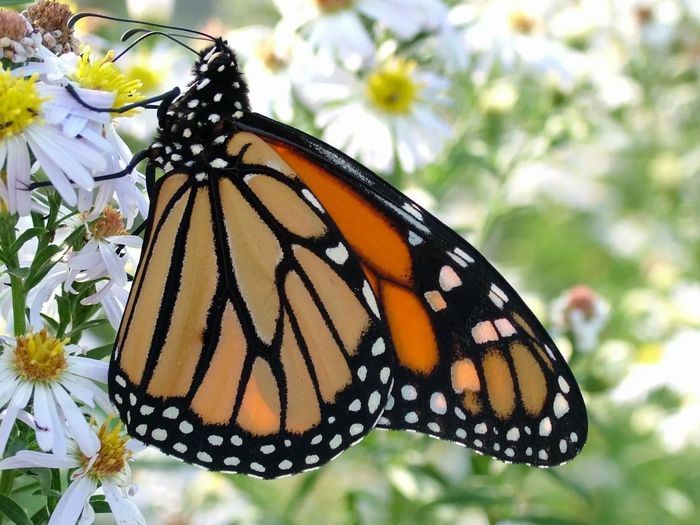Monarchs are on the verge of gaining endangered species status
Make America Wild Again

If you’re not mesmerized by monarchs, then you've lost your sense of wonder.
Monarchs are on the verge of gaining endangered species status
Signed in as:
filler@godaddy.com

If you’re not mesmerized by monarchs, then you've lost your sense of wonder.
Check out this great video

Our goals are to educate, advocate and motivate. We advocate by attending public meetings with local and state governments to include milkweed in their landscape/cityscape plans. Additionally, we provide free milkweed seeds through educational and outreach programs with local libraries, schools and community events which we hope motivates people to plant them in public and private spaces around their communities.

No other butterfly species travels further than the monarch. Driven by changes in seasonal temperatures, monarchs fly south and roost in tranvolcanic mountain forests high in the mountains of Mexico.

Flying in large groups, these beautiful creatures migrate up to 3000 miles. They fly north and east looking for milkweed plants on which to lay their eggs. If they leave too early, before the milkweed has bloomed in the spring, they will not be able to lay their eggs and continue the cycle.

Milkweed is THE host plant for monarchs. It is the only plant on which they can lay their eggs and their caterpillars can feed. In the spring, caterpillars hatch and metamorphose into orange and black adults.
Photo courtesy of Barb Young

The new monarchs, the young of the butterflies that made the fall journey, recolonize their parents' original homes. There can be three or four generations of monarch butterflies, depending on the length of the growing season. Since each female lays hundreds of eggs, the total number of monarch butterflies increases throughout the summer. Before the summer ends, there are once again millions of monarchs all over the U.S. and southern Canada.
Photo courtesy of Barb Young

After 2 weeks inside the chrysalis, a butterfly emerges. It takes some time for its wings to dry and harden before it can fly. Adult monarchs feed on nectar from various flowers, but they retain a special connection to milkweed,
Photo courtesy of Barb Young

Due to the use of pesticides, insecticides and deforestation, their milkweed habitat has been destroyed. As a result, monarch numbers have declined by 90% since the 1990s. This puts them at high risk for extinction.
Photo courtesy of Barb Young

The monarch is a keystone species, meaning when their numbers decline it is an indication of the health of other pollinator populations, which directly impacts human foods.



Monarchs' decline is a forecast of widespread environmental change. The dwindling population of these butterflies, along with the decline of many other butterflies and bees, threatens us too, since the food security of humans depends pollinator species. Monarch butterflies could quickly disappear unless people take action to protect them.

The 2023-2024 winter figures not only represent the second-worst year ever recorded for the butterflies in central Mexico since monitoring began in 1993, but the report is also considered a benchmark for the overall health of the species.

The loss of milkweed plants in the monarch’s spring and summer breeding areas across the United States is believed to be a significant factor contributing to the reduced number of monarchs recorded in overwintering sites in California and Mexico. Agricultural intensification, development of rural lands, and the use of mowing and herbicides to control roadside vegetation have all reduced the abundance of milkweeds in the landscape.

Where Monarchs thrive, other species do as well. Quail are an important part of the ecosystem and economy in Alabama.
One step closer to protecting and restoring the Monarchs.
Monarchs are not migrating South as expected
In progress. Please be patient.
Every contribution helps us achieve our mission of planting native milkweed and restoring the Monarch butterfly.

Roundstone Native Seed has been growing and supplying clean, high quality, regionally adapted Native Seed to the Eastern half of the US for over 20 years. We have grown from a small family-owned business to one of the largest seed providers in the East. Our success can be attributed to the quality of our seed, our development of locally a
Roundstone Native Seed has been growing and supplying clean, high quality, regionally adapted Native Seed to the Eastern half of the US for over 20 years. We have grown from a small family-owned business to one of the largest seed providers in the East. Our success can be attributed to the quality of our seed, our development of locally adapted seed, and our knowledgeable staff dedicated to friendly helpful service. Whatever your seed need is, with over 300 individual species, 125 standard seed mixes, and unlimited custom mixes, we have what you need. Just contact us and we’ll be happy to talk with you about your needs. https://roundstoneseed.com
Be the first to hear about our upcoming events and ways to get involved.
We use cookies to analyze website traffic and optimize your website experience. By accepting our use of cookies, your data will be aggregated with all other user data.